In this episode, a huge submarine volcano erupts, breaks the surface of the ocean, and forms a new island. What happens next?
Guests:
- Tracy Gregg, associate professor of geology at the University at Buffalo
- Rebecca Carey, senior lecturer at the University of Tasmania
- Paraskevi V. Nomiku, assistant professor of geological oceanography at the University of Athens
- Gianpierro Orbasano, Tongan photojournalist and explorer
- Michael Bates, Prince of Sealand
- James Grimmelmann, professor of law at Cornell Tech
Further reading:
- Hunga Tonga volcano eruption forms new S Pacific island
- New Pacific Island Could Resemble Ancient Martian Volcanoes
- Tonga Underwater Volcano Eruption Disrupts Flights
- VOLCANO OFF THE COAST OF ICELAND FORMS A NEW ISLAND
- Savage Earth
- New Tonga Volcanic Island May Surivive Much Longer Than Expected
- “I rule my own ocean micronation”
- The largest deep-ocean silicic volcanic eruption of the past century
- Tsunami hazard risk of a future volcanic eruption of Kolumbo submarine volcano, NE of Santorini Caldera, Greece
- Volcanic ash as fertiliser for the surface ocean
- The Submarine Volcano Eruption off El Hierro Island: Effects on the Scattering Migrant Biota and the Evolution of the Pelagic Communities
- What is law of the sea?
- United Nations Convention on the Law of the Sea
- Principality of Sealand: Nation Building by Individuals
- Sealand, Havenco and the Rule of Law
- Hunga Tonga volcano eruption forms new S Pacific island
Flash Forward is produced by me, Rose Eveleth. The intro music is by Asura and the outtro music is by Hussalonia. The episode art is by Matt Lubchansky.
If you want to suggest a future we should take on, send us a note on Twitter, Facebook or by email at info@flashforwardpod.com. We love hearing your ideas! And if you think you’ve spotted one of the little references I’ve hidden in the episode, email us there too. If you’re right, I’ll send you something cool.
And if you want to support the show, there are a few ways you can do that too! Head to www.flashforwardpod.com/support for more about how to give. But if that’s not in the cards for you, you can head to iTunes and leave us a nice review or just tell your friends about us. Those things really do help.
That’s all for this future, come back next time and we’ll travel to a new one.
FULL TRANSCRIPT BELOW
▹▹ ▹▹ ▹▹ ▹▹ ▹▹ ▹▹ ▹▹ ▹▹ ▹▹ ▹▹ ▹▹ ▹▹ ▹▹ ▹▹ ▹▹ ▹▹ ▹▹ ▹▹ ▹▹ ▹▹ ▹▹ ▹▹ ▹▹
Hello and welcome to Flash Forward! I’m Rose and I’m your host. Flash Forward is a show about the future. Every episode we take on a specific possible… or not so possible future scenario. We always start with a little field trip to the future, to check out what’s going on, and then we teleport back to today to talk to real life experts about how that world we just heard might really go down. Got it? Great!
This episode we’re starting in the year 2022.
[waves, fishing boat sounds]
[radio sound]
Marion: Ethel, Ethel this is the Marion, on channel 16 over.
Ethel: Marion this is Ethel over
Marion: Ethel switch over to channel 71
Ethel: switching to 71.
Marion: Ethel have you been to Henry Bay today?
Ethel: Yeah passed through a few hours ago.
Marion: You see anything weird?
Ethel: No, why?
Marion: I gotta lotta dead fish floating around in the water.
Ethel: Dead fish?
Marion: Yeah just floating around, thousands of ‘em.
[bubbling, crackling]
Marion: And the water’s weird. It’s like, soda bubbling or something.
Ethel: You been drinking too much?
Marion: No more than usual!
[louder bubbling, weird sounds, sloshing, radio crackling]
Ethel: Marion you okay out there?
[explosion sounds]
Marion: (shouting) There’s some kind of explosion! A volcano? I think it’s a volcano!
[explosion sounds fade out]
[waves, fishing boat sounds]
Ethel: Marion, Marion, Marion, this is Ethel on channel 16 are you okay over.
Marion: Ethel this is Marion I’m okay.
Ethel: What the hell happened?
Marion: Must be a volcano, I’m watching it now. Tons of smoke and ash erupting up out of the ocean. Must have killed the fish before it reached the surface.
Ethel: Probably wanna get out of there right?
Marion: Yeah I’m moving, over and out.
[waves, fishing boat sounds]
Ethel: Marion, Marion, this is the Ethel
Marion: Ethel this is Marion, over.
Ethel: You go by Henry Bay today?
Marion: Nah, had my excitement for the week.
Ethel: There’s an island here now.
Marion: An island?
Ethel: Yeah I guess the volcano made an island man. We should have a party out there.
Marion: All that ash going to clog up your intake you know.
Ethel: I’m not sticking around long.
Marion: How close are you?
Ethel: 50meters I’d say. Looks pretty solid. Wanna check it out tomorrow.
Marion: Why not, 11 hundred?
Ethel: See you then, over and out.
<fade out>
Rose: So this episode is about a future in which a huge underwater volcano erupts, breaking the surface of the ocean, forming a new island, and generally wreaking havoc. This episode was suggested by listener and longtime friend of the show, Charlie Lloyd. And in fact, while this might seem far fetched, it’s actually not at all. There are tons of volcanoes underwater.
Tracy Gregg: So on Earth there are over 60,000 kilometers of mid-ocean ridges, and they’re really just a long line of volcanoes. So it’s the largest volcanic chain of mountains on the planet. But we don’t see it because it’s underwater.
My name is Tracy Gregg and I am an associate professor of geology at the University at Buffalo, in Buffalo New York and my area of expertise are volcanic eruptions and I have studied them everywhere from the moons of Jupiter to the bottom of the ocean.
Rose: So there are 60 thousands kilometers of mid-ocean ridges, which, is the equivalent of over 37 thousand miles for those of us still imprisoned by the Imperial system. To put that into context, the circumference of the Earth is just under 25 thousand miles. So there is enough mid-ocean ridges to circle the earth one and a half times, approximately. And along all those thousands and thousands of miles of mid-ocean ridge, there are volcanoes. And those volcanoes are actually erupting all the time, we just never know about it. On land, scientists use high-tech monitoring systems to detect volcanic eruptions even before they even happen.
Tracy: We listen for earthquakes that are, I say listen, they are subsonic, we can’t actually hear them but but we have instruments that can feel the vibrations caused by magma, molten rock, moving underground. And that’s a much better signal that something’s happening than our eyes.
Rose: On dry land, there are lots and lots of these seismometers in the ground all over the world. But underwater? Not so much.
Tracy: It’s just a lot more expensive and a lot harder to put those seismometers in place under two and a half kilometers of seawater.
Rose: In fact, there are only two regions of the entire mid-ocean ridge that have these monitoring devices in place.
Tracy: One is off the coast of Oregon along what’s called the Juan de Fuca Ridge
Rose: If you read that New Yorker piece about the really big earthquake that could destroy all of Seattle, this is the ridge it was talking about.
Tracy: and another off the coast of Mexico. West Coast of Mexico it’s called the East Pacific Rise. Those are places that we know are active and they are monitored and we can listen for those earthquakes. But that’s two spots along 60000 kilometers of So it’s happening all the time and we don’t see it.
Rose: Most of the time, these eruptions happen without breaking the surface of the water. Which makes sense when you think about it right? On Earth, when a volcano erupts really violently, what we’re generally seeing is a ton of dissolved gases hitting the air and EXPLODING.
Tracy: And I think most people’s everyday experience with this would be a soda pop or a beer bottle where you grab that bottle and you look at it and and you don’t see any gas in there but you shake it up and that foam rises to the top and you know there’s gas in there. Now you can see it. And you know what happens when you open a soda pop bottle that you’ve shaken. Right. It blows up.
Rose: So on land an explosion would be like opening that bottle, which is easy to open. But underwater, there are thousands of pounds of water on top of your bottle cap.
Tracy: So if if the gas is kept under pressure with your soda pop that’s keeping the lid on then it’s not going to explode. Well water weighs a lot and so volcanoes on the bottom of the ocean under two and a half kilometers of water. They’re also under a lot of pressure and so that gas that’s inside the magma doesn’t want to come out it doesn’t want to make bubbles it wants to just stay dissolved in the magma. So if you take the same magma with the same amount of gas and you erupted on land and you interrupt it underwater on the deep sea floor on land it will explode underwater. It won’t. It will just create a lava flow.
Rose: What that means is that some of the most powerful eruptions underwater never actually break the surface at all. In fact, in 2012, the largest deep-ocean volcanic eruption of the last century was only discovered by accident, thanks to a woman who happened to notice something while she was looking out the window of an airplane.
Rebecca Carey: A passenger on a commercial airline jet was flying from Tonga to Auckland and she looked out of her window and she could see these gigantic tan like accumulations on the sea surface
Rose: This is Rebecca Carey,
Rebecca: from the University of Tasmania and I am a volcanologist.
Rose: So this woman’s plane landed in New Zealand, and she called up a group of scientists there to ask them what the heck this thing was that she saw.
Rebecca: and that really triggered a process within Geological Nuclear Sciences New Zealand to try and discover exactly what these features were.
Rose: So the scientists went out to look, and what they discovered was that this weird thing in the ocean that this woman had seen was not an oil slick or anything like that. It was a pumice raft,
Rebecca: So a pumice raft is essentially a accumulation of volcanic pumice classmates that are buoyant they’re full of holes that sit together on the ocean surface.
Rose: And this particular pumice raft had come from a volcano known as Havre.
Rebecca: Havre volcano is a submarine volcano that’s located on a submarine volcanic chain that extends north of New Zealand towards Tonga. It’s approximately a thousand kilometers north north east from Auckland.
Rose: Now, scientists knew about Havre before this 2012 pumice raft, they had first discovered and mapped the volcano in 2002. So when they saw the pumice, they suspected it might have come from Havre. But they had seen no other signs of an eruption. Even once they were able to determine that this pumice had come from Havre, they had no idea how strong the eruption had been. The size of the pumice raft told them something:
Rebecca: We had a qualitative sense that this was a very powerful event. The pumice raft itself had a volume of about 1 cubic kilometer so that’s equivalent approximately to them out the 1980 large Mount St. Helens event.
Rose: But a pumice raft alone can’t tell you everything
Rebecca: But that we only saw the surface manifestation of what had happened we had no idea of what had happened on the seafloor whether it was a single vent multiple vents and an area where those vents were. We didn’t know we virtually nothing knew nothing.
Rose: So scientists decided to go back to Havre and revisit the volcano. They had a map from their 2002 studies, and with this new data they could compare how the topography had changed, and they could assume that most of that change was probably from the eruption. So Rebecca and her team set out to examine the volcano using a couple of different high-tech tools, including…
Rebecca: A remotely operated vehicle called Jason. I think we spent 240 hours on the sea floor. And secondly an autonomous vehicle called Century.
Rose: Taken altogether, the mapping, the submarines, all the work they’ve done, what Rebecca and the other researchers found was that this explosion had been really, really big.
Rebecca: The largest deep ocean silicic eruption of the past century.
Rose: And the word silicic in there just refers to the type of magma that came out of the volcano. It’s the same type of magma that came out of Saint Helens when it exploded in 1980. And in fact, the researchers think that this eruption was as big and as powerful as that 1980 eruption at Saint Helens, which killed 57 people, decimated hundreds of square miles, and caused billions of dollars worth of damage. This 2012 Havre eruption was basically like taking the Saint Helens blast, and putting it underwater. And we would never have even known about it if it hadn’t been for someone noticing the pumice raft.
But if the largest eruption of this kind in the past century didn’t manage to break the surface of the water, what does it take?
Tracy: So a really good example of a volcano breaking the surface is Surtsey. This erupted off the coast of Iceland in 1963.
Rose: That’s Tracy Gregg again.
Tracy: It started on the bottom of the ocean and the first things to come out of the volcanic vent on the bottom of the ocean was just lava. There were no explosions because the water was deep enough and there wasn’t enough gas in the magma.
Rose: But the eruption kept going, so the lava started piling up, piling up, piling up, and the weight of the water keeping it down started getting less and less and less
Tracy: So as the lava pile grows and gets closer to the surface the gas that’s in there is more likely to be able to explode and when water comes in contact with this really hot lava the water wants to turn into steam and water turning into steam can also create an explosion.
Rose: Remember, all of this is totally invisible to humans at this point. It’s happening underwater, and there are no sensors down there to tell anybody that anything unusual is happening.
Tracy: But if you were there in a submarine you could see underwater explosions with steam and flashes of lava and heat. And it looked really cool.
Rose: So this volcanic eruption is just slowly building its way towards the surface. And in fact the first people to notice that anything weird was happening, were fishermen.
Tracy Gregg: It’s not far from an island that’s famous for its fishing and so the fisherman noticed bubbling in the water and they noticed dead fish in the water and they noticed nasty smells of sulfur in the water and that sulfur is volcanic gas that’s coming out of the lava.
Rose: So the fishermen start radioing each other and being like “hey something weird is happening over here.” And then, on the November 14th, 1963, a cook on the boat Ísleifur II, radioed in to report smoke, rising from the ocean.
Tracy: And then… big explosions. Big Explosions! Shooting out steam and ash as the lava was blasted into pieces by the water turning into steam and creating these explosions and then all this ash started piling up on the surface of the ocean.
Rose: Thankfully, nobody was injured during the eruption.
Tracy: I mean fortunately in this particular case certainly it was off the coast of Iceland. And so the fishermen were all from Iceland and they were quite familiar with volcanic eruption so they weren’t too they weren’t too upset. They were annoyed at their inability to go fishing.
Rose: This eruption lasted from November 1963, and didn’t officially end until June of 1967. And by the end, there was a whole new island there, formed by this volcano.
The island was named Surtsey, after a legendary figure in Icelandic mythology named Surtr… I think I’m pronouncing that correctly but I’m probably not. He’s not a god exactly, more like a giant, and he’s often depicted with a fiery sword. A giant of fire, like the volcano, if you will. And the island that bears his name is still there today. It’s about a half a square mile, all told. Nobody lives there, but scientists are studying both the geology and ecology of the new island. The first plant life was observed on the island in 1965. In 1983 a group of 70 seals made Surtsey their new breeding spot. In 1984 a gull colony moved in.
And the volcano probably didn’t just change the ecology and geology above ground either. There are lots of studies that show that underwater volcanoes, even ones that don’t break the surface, can impact the chemistry and biology of the surrounding areas.
So the Surtsey eruption broke the surface because it was able to build up enough lava to wind up close enough to the surface that the pressure could no longer contain the eruption.
But there’s another way for an eruption to break the surface too, which is to simply be shallower to begin with. And that’s what happened in 1650, off the coast of Greece.
Rebecca: So Kolumbo volcano is quite close to Santorini volcano. It actually was quite a shallow eruption around 200 feet 50 meters depth but it was very powerful and it was a significant volume, probably twice the volume of what was erupted at Havre.
Paraskevi Nomiku (Evi): Kolumbo is the most active submarine volcano in the Mediterranean Sea.
Rose: This is Paraskevi Nomiku
Evi: Most of my friends call me Evi Nomiku, and I’m an assistant professor of geological oceanography at the University of Athens in the department of geology and the environment
Rose: Evi has spent the last ten years studying the Kolumbo volcano, which sits in the water just five miles off the coast of the island of Santorini in Greece. And in 1650, Kolumbo erupted.
The first sign was a few earthquakes, but since earthquakes aren’t particularly uncommon in the area most people ignored them. As they got stronger, everybody assumed that the eruption might come from the nearby volcanoes on land, but they didn’t seem to be smoking or showing any signs of eruption. Then, the ocean turned a weird color for a couple of days, a sign that the eruption was happening beneath the surface. Then, on September 27th, dense clouds of smoke and ash started to rise from the ocean, bringing with them horrible noxious fumes.
Evi: There were more than 70 people that they were died due to the poisonous gases that they were releasing during the eruption in Santorini.
Rose: Eventually, people saw a peak coming up out of the water.
Evi: There was building a huge cone, and then the people understood that OK an eruption is going on because they saw the peak of that cone.
Rose: A few days later the volcano really blew, and one account from the time called that day, September 29th, 1650, “the most terrible day. The earth quivered and the air was afire. Thick sulphurous steam billowed out of the depths. Then suddenly the clouds caught fire, lightning rent the sky, thunder burst forth and strange forms moved before one’s eyes: flying snakes shining spears and lances and whirling blazed torches.”
The eruption was so powerful that some sources say it was heard as far as Dardanelles, nearly 250 miles away.
But it wasn’t just the gases that caused problems. The eruption also caused a tsunami that swept over the island.
Evi: And of course there was created a huge tsunami that in the height of more than 20 meters. That was all the Eastern part of Santorini was destroyed completely.
The tsunami carried away livestock, destroyed buildings and ruined fishing vessels and other fleets.
In 1650, the eruption wound up killing over 70 people. But that was, 1650. WAY more people live on and travel to Santorini today. Two million people visit every year. In fact, there are so many tourists trying to go to Santorini, that a few years ago the local government voted to limit the number people that were allowed to get off cruise ships each day to 8,000.
And Evi’s work has shown that Kolumbo is still a threat.
Evi: We know that this volcano is very active because we found in 2006 a very active hydrothermal vent field at the depth of 500 meters.
Rose: Evi and her team found over 100 active hydrothermal vents around Kolumbo, and they were all letting off super hot gases, which suggest to them that the volcano is still active. But there are no sensors in the ground near Kolumbo, and Evi has been trying to get money to do more studies and send more rovers down there to understand it.
Evi: No unfortunately no. There are not any kind of equipment on the seafloor, only chimneys and bacteria.
Rose: Strangely enough, nobody in Santorini seems all that worried that there’s a volcano right offshore that could decimate the island.
Evi: I am from Santorini, I was born in Santorini. OK. My family is still there. I think they do believe that this will not happen in the future.
Rose: And because they can’t see the volcano, it’s easy to forget about it.
Evi: I think this is happens to all the submarine volcanoes all around the world, because they believe that it’s far away from land, they say they say to themselves “OK it’s on the seafloor, so we don’t need to worry about this volcano.”
Rose: But all of Evi’s work shows that it’s possible Kolumbo could erupt again. In fact, it’s easy to imagine another big volcanic explosion in all sorts of parts of the world. One big enough that it causes a tsunami and creates a new island. But what happens next? And would we be able to predict it or react quickly enough? That’s what we’ll talk about, after this quick break.
[[ADS]]
Rose: So at this point we’ve established that this kind of eruption can happen. So what happens next depends largely on where the volcano actually is. If it’s off the coast of Iceland, chances are it won’t kill anybody. If it’s off the coast of Santorini, it would be far more dangerous.
If Kolumbo erupted, Evi says there would be some warning signs, like earthquakes. Using sensors scientists can figure out if the earthquakes are caused by just regular tectonic activity, or caused specifically by the volcano.
Evi: You can study the signalds of the earthquakes, and scientists can understand if the earthquakes are volcanic.
Rose: So if they see regular earthquakes that behave like earthquakes caused by magma, they can guess that the volcano might erupt.
Evi: if you see that we have for example for six months of three or four months earthquakes in this specific region, in the Kolumbo area, that means something is going on with the volcano.
Rose: But there’s no knowing for sure exactly if, or when it might happen. Which is why Evi wants money to put more detectors down in the ocean near Kolumbo.
But any eruption that breaks the surface near a population center would certainly disrupt flights, and cause general travel chaos.
And after all of that, you might have a brand new island. Like Surtsey, or like the island that was formed off the coast of Tonga.
News Clip: Thrill seeking boaties have given us the chance to get a close up view of an exploding volcano. The eruption is under water just off the coast of Tonga’s main island.
In 2009, a submarine volcano 28 miles off the coast of Tonga began spewing ash and pumice out of the ocean.
News Clip: Nature’s power on full display, as an underwater volcano burst to the surface spewing columns of hot ash, smoke and steam, thousands of meters into the air. Recreational fisherman Lothar Slabon, originally from Germany, journeyed out to the site to witness the dramatic explosions in what used to be his favorite fishing spot. He said he could see burning seabirds falling from the sky.
Rose: After that 2009 eruption, there was a tiny, unstable island made up of volcanic ash, pumice and rocks. Eventually, the volcano calmed down, but then in December 2014, another eruption boke the surface. And the landmass that began in 2009 got bigger and more stable. It was actually starting to look like a proper new island.
Experts warned anybody from going to the island. It was too dangerous, too unstable, they said. But that didn’t stop this guy.
Gianpierro Orbassano (GP): My name is too long. Why everybody call me GP, Orbassano, is my family name.
Rose: GP is short for Gianpierro, and GP used to be a photojournalist, the prospect of getting the first photographs of a brand new island was too exciting to pass up. In fact, he had arranged a special flight in 2009 to see the volcanic eruption when it was first happening. So in 2014 he set out again on a boat with a few friends for the new land mass.
GP: And was not so easy to land. Finally we land and we were the first people going up and putting our feet on top of the island.
Rose: But despite being the first human to set foot on the new land, GP didn’t claim the island for himself.
GP: I just put the flag on my soccer team in Italy.
Rose (on the phone): Who’s your team?
GP: Torino! Torino.
Rose: And in fact, GP doesn’t have a ton of interest in going back. The land is unforgiving, there’s no water or shade, and it’s incredibly hot.
GP: No it was a very, I can say very very hot, very hot, was a sunny day and all black. And you can imagine it was really really hot.
Rose: And the island isn’t solid, the ground is still really soft.
GP: So was not so easy to go up and especially to come down, was all really really fragile, the ground.
Rose: But when they reached the top, it was all worth it.
GP: Volcano create a lake. Because the sea water and rain also came into the hole of the volcano, and there was a green lake, big. it was absolutely fantastic. The view was beautiful was plenty of birds flying all around all around all around as soon as you move thousands seabirds surround you, it was really something.
Rose: For now, GP will wait until the volcano erupts again. If it does, he’ll be out there with his camera, but until then, he’ll just look at the new island from afar.
But at some point, if the conditions and location are just right, someone will try to claim one of these volcanically formed islands right? They may not have a lot of resources but they do offer the allure of having your very own island. And if you play your cards right, you could even try to turn that island into its own nation.
That’s what Roy Bates did back on September 2nd, 1967,when he official declared independence for the nation of Sealand. Sealand isn’t a volcanic island. But it does provide an interesting window into what it’s like to try and create your own island nation in the modern era. It wasn’t a volcano that built the physical land of Sealand, but instead the British navy.
James Grimmelmann: So Sealand used to be called Roughs Tower. It was a coastal defense platform built by the British in the Thames Estuary during World War II.
Rose: This is James Grimmelmann
James: I’m a professor at Cornell Tech. I work on Internet law.
Rose: James wrote a paper on a certain thing that happened on Sealand that we’re going to get to in a little bit, but he wanted to begin that paper with a quick history of Sealand.
James: So people had written a little bit about the history before, and I just meant to write a short paper about the big lessons for what it means for law and I just got sucked down the rabbit hole researching the history.
Rose: And we are going to fall down that rabbit hole a little bit here too. So, back to Rough’s Tower. It was actually one of a handful of towers built out in the Thames estuary. So World War II ends, and the British Navy abandons them. Then, in the 1960’s
James: Pirate radio broadcasters set up there in the hopes of evading their British rules on putting Rock and Roll on the air.
Michael Bates: The United Kingdom only had the BBC, there was no no pop music for the kids were just classical music and an in-house BBC orchestra.
James: And then Britain effectively extended its power far enough to put the pirates out of business. But one of them, a guy named Roy Bates, just stayed anyway. And he moved his family onto this place, and then decided to make his own country called the Principality of Sealand. And he and his family have been there ever since.
Michael Bates: Yeah my name is Michael Bates or Prince Michael of Sealand, depending on the occasion, and I am the reigning monarch of the Principaliy of Sealand.
Michael: When we first went there I was let me think, 14, I was 14 and I was with my dad. Christmas Eve 1966, when we took it over and I went and stayed out there. I left school early at 14 years old in my Easter holidays. I suppose I was at boarding school in Wales.
Rose: Michael’s first impressions of Sealand honestly sound kind of terrifying
Michael: It was unreal, you know there was like, down the bottom of the tower, there are rooms all the way down the towers. Each tower is seven floors, and down the bottom of a cormorant bones from the big seabirds, cormorants, where they’ve managed to find their way down there but couldn’t get the angle of attack to fly out. And it was just like it’s been left from the war.
Rose: Roy Bates, Michael’s dad and the founder of Sealand, passed away in 2012. So now Michael runs the place. And when he dies, he’ll pass Sealand on to his kids.
Michael: Well my oldest son James he’s, what is he now, 31, he’s next in line. And then behind him is Liam who’s nearly 30, he’s 29 now, and then the next one after that will be, well I suppose do we jump girls these days? I’m not quite sure, my daughter is 26.
Rose (on the phone): Well it’s your nation, you get to decide if there are women in charge right?
Michael: We’ll get to that one when we get to that one! (laughs)
Rose: Now, according to Sealand, they are a sovereign nation. According to the UK, they are not.
Michael: Well according to the Montevideo Convention, to create your own country you need a population you need a territory you need a government and you need the capacity to enter into relations with other states. Of course we have all of that.
Rose: So the Montevideo Convention on the Rights and Duties of States is a treaty that was signed in 1933. And that treaty says that for a state to be legitimate it has to have four things. First: population, check, someone lives on Sealand all year round. Second: territory. The Bates claim that by abandoning the towers, the UK gave up their rights to them.
Michael: There was dereliction of sovereignty. The British government walked away and left it back in the back in the 50s.
Third: a government, sure, Sealand has a government. And Fourth: The capacity to enter into relationships with other states. Well, they had the German ambassador out to the tower once to discuss something which… we’ll come back to in a second. And Michael says they were once in communication with the French president, and that’s quite enough recognition for them.
So, according to the Bateses, Sealand checks off all the boxes. The UK, on the other hand, does not see Sealand as independent at all. And technically, today, Sealand sits in UK water. In 1987, the United Kingdom extended its territory from 3 miles from the coast to 12, which enveloped Sealand. Plus, they don’t recognize the German and French chats as legitimate recognition by foreign governments. But the UK doesn’t really want to force the question either. So far, there’s been no real harm to letting the Bateses claim they operate this nation of Sealand in the Thames Estuary. And removing them would certainly be a media spectacle and probably make the UK look bad and the Bateses look like martyrs. So they just kind of let them be.
So Sealand carries on, continually coming up with new ways to fund their nation and stay in the news.
Michael: We have a football team and it’s small for that. We keep losing the ball.
Rose: They even sell Lord and Lady titles online.
Rose (on the phone): If I buy a Lady title what does that mean? What do I get?
MIchael: Well you get a magnificent looking document, framed document, you can put on the wall and you can you can put it on you know identity on your passport. And you’re a supporter!
Rose: Over the years Sealand has been at the center of a handful of, odd events. That German ambassador’s visit that I mentioned? The one that they count as “entering into agreements with foreign nations?” Well, the German ambassador was there to discuss a hostage situation.
James: Roy Bates got connected with some Germans who had of grand plans to invest a lot of money in the island and turn it into a seaport offshore casino basically develop this thing into a huge new offshore project and the whole thing mostly appears to have been a scam on their part.
Rose: So they lured Roy and his wife off the tower to a meeting, and while the rulers of Sealand were gone, they sent some Germans to land and take the tower over.
James: They landed under false pretenses, tossed his son Michael basically in one of the legs of the tower for a while to imprison him. Then eventually stuck him on a boat for shore.
Rose: So when Roy and his wife realize what has happened they rush back to Sealand.
James: And with the aid of a friend who was a helicopter pilot, they actually successfully invaded Sealand held the one German and two Dutchman under arrest for a while.
And since there was a German national being held on the tower, the German ambassador had to get involved.
James: It’s hard to know how seriously to take the whole thing. But if you take the Sealand side of the story seriously, the Germans sent somebody out to take a look, and this amounts to diplomatic recognition of an independent nation. That’s probably not right. But a few guys on a platform of the ocean are capable of creating a major diplomatic embarrassment.
Rose: Then there was the fire that nearly destroyed the tower and that the British Coast guard helped put out, and then… there was Havenco.
James: So in the height of the dotcom boom, the last time people were worried about excessive government control of the Internet. Some entrepreneurs with a libertarian bent thought hey if we put some servers on Sealand then we’ll be outside the reach of every government in the world. We won’t need to worry about Chinese censorship or Saudi attitudes towards pornography or American copyright law. We’re going to be an independent jurisdiction and it will be almost anything goes. You know, no child pornography, but you want to have a gambling site? Go on! Put it on Sealand and we’ll use Sealand’s sovereignty as a way of guaranteeing Internet freedom. So they got some investors they struck a deal with the Bates’s and they moved out there and stuck servers in the legs of this platform.
Rose: This brings us to the reason that James wrote his paper on Seland in the first place. Because Havenco, this offshore set of servers, is a classic case study in internet law.
James: It’s one of these examples that everybody talks about in their class, because it’s so colorful.
Rose: And the question at hand is this: What type of law governs those servers? Is it international law? British law? Sealand law? None of the above? It turns out the answer is… complicated. And James’s paper is largely about the three kinds of things we could be talking about when we talk about law, and Havenco. First: national law.
James: These are all of the laws that have been coexistent help it’s quite get around so I mentioned you know Saudi pornography laws and American copyright law. Havenco existed so that its clients didn’t have to comply with those laws if they didn’t want to.
Rose: Second: international law.
James: Which is the law we’re talking about when he says that it’s the law that says Sealand is an independent state. It’s international law that supposedly gives Sealand a right to ignore what every other nation on earth wants.
Rose: And the third kind of law here is Sealand law.
James: The laws of Sealand itself. Those are the laws that say “actually you can’t put child pornography on anything you host here.” And that also create a justice system. Sealand law was what was being invoked when they put the German on trial after the Civil War.
Rose: So when legal scholars think about Sealand, they have to balance these three kinds of laws and figure out which ones apply in which situations. Of course, this is complicated further by the fact that most countries don’t recognize Sealand law at all, since they don’t recognize Sealand as an independent nation. We don’t have time to get much deeper into into the specific legal ins and outs on this episode. You can read James’s whole article on the legal arguments surrounding HavenCo and Sealand online, I’ll post a link to it in the show notes. It’s totally worth it even if just for the extra Sealand historical bits that I didn’t include here, including a RedBull skateboarding special and some perpetual motion machines.
Anyway, ultimately Havenco failed, for a number of reasons, not the least of which was cost.
James: It turned out that criminals had other options. It turned out that putting your servers on a platform off the coast is pretty expensive compared to other options.
Rose: But the whole point of this detour into Sealand and Havenco, is because I wanted to know, what if there was an island, formed by a volcano — see here we are, back on track! — could those who settle on it build something like Havenco? Could they create an offshore nation, free from the laws of the rest of the world, and use it to create a truly open and lawless internet? It’s possible!
James: It’s an interesting question. I think you see similar questions around what will space colonies look like, and Seasteading obviously raises similar ideas.
Rose: But.. remember, any volcanically formed island is going to be really hostile to live on for a long time. There will be no plant life, no trees, no shade, no power. In that way, it’s actually a lot like Sealand.
James: It’s a fascinating place! Great adventure! Really bad for building a life across generations. It takes some pretty extraordinary efforts on behalf of the Bates family to make even as much of it as they have. But no one else wants to live there. It’s not a great environment for a long term anything to build a complex commercial industrial, you know, post-industrial society on.
Rose: But let’s be clear: just because something would be incredibly expensive, ill advised, and generally overly complicated, doesn’t mean that someone won’t try it! In fact, James thinks that Sealand, and our hypothetical data center on a newly formed volcanic island, are good metaphors in general for the ways that technologists can sometimes try to build an entire culture and world around a single invention or innovation.
James: And I think the same thing is true of a lot of other utopian fantasies about technology. Bitcoin and smart contracts, really interesting, they may have some great applications. I cannot imagine that you want to build your society on a basis of pure smart contract enforcement with no human discretion built into it.
Rose: So if you are waiting, with bated breath, hoping for a submarine volcano with just the right power, at just the right depth, in just the right location, so you can go stake your claim and create your nation, that’s what you need to know. And I’ll leave you with a word of advice from Michael, the prince of Sealand.
Rose (on the phone): So let’s say that there was um, an island created by a volcano, so there’s an island now that suddenly just popped up. Let’s say someone was to go claim it. Do you have any advice to them as someone who’s maintained a sovereign nation for over fifty years? Do’s and don’ts?
Michael: don’t do it!
No I don’t. I don’t mean that at all. I don’t mean that at all, but, you know, you don’t get a lot of help with it.
Rose: So, there you have it. Maybe just … don’t?
[music up]
That’s all for this episode. To find links for more information about anything we talked about this episode, check the show notes or go to FlashForwardpod.com.
Flash Forward is produced by me, Rose Eveleth. The intro music is by Asura and the outtro music is by Hussalonia. The episode art is by Matt Lubchansky.
If you want to suggest a future we should take on, send us a note on Twitter, Facebook or by email at info@flashforwardpod.com. We love hearing your ideas! And if you think you’ve spotted one of the little references I’ve hidden in the episode, email us there too. If you’re right, I’ll send you something cool.
And if you want to support the show, there are a few ways you can do that too! Head to www.flashforwardpod.com/support for more about how to give. But if that’s not in the cards for you, you can head to iTunes and leave us a nice review or just tell your friends about us. Those things really do help.
That’s all for this future, come back next time and we’ll travel to another one.
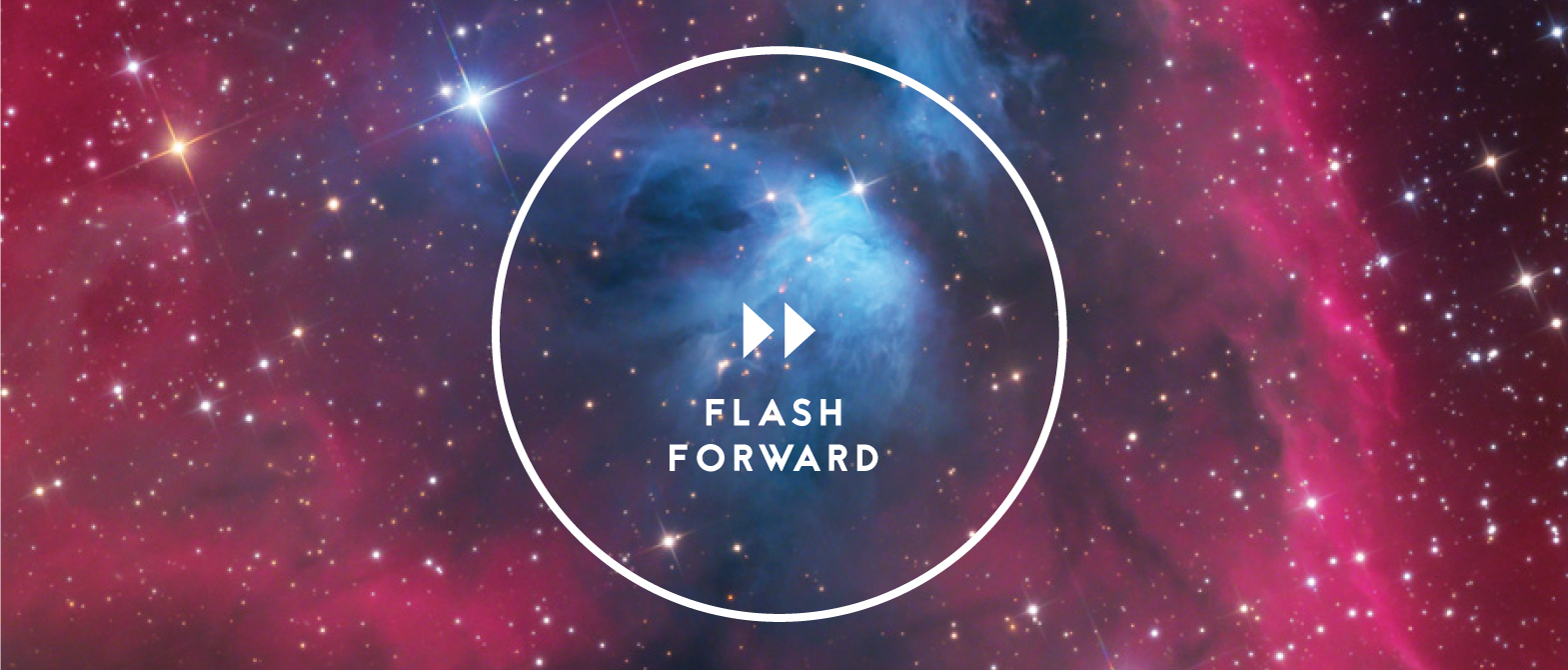
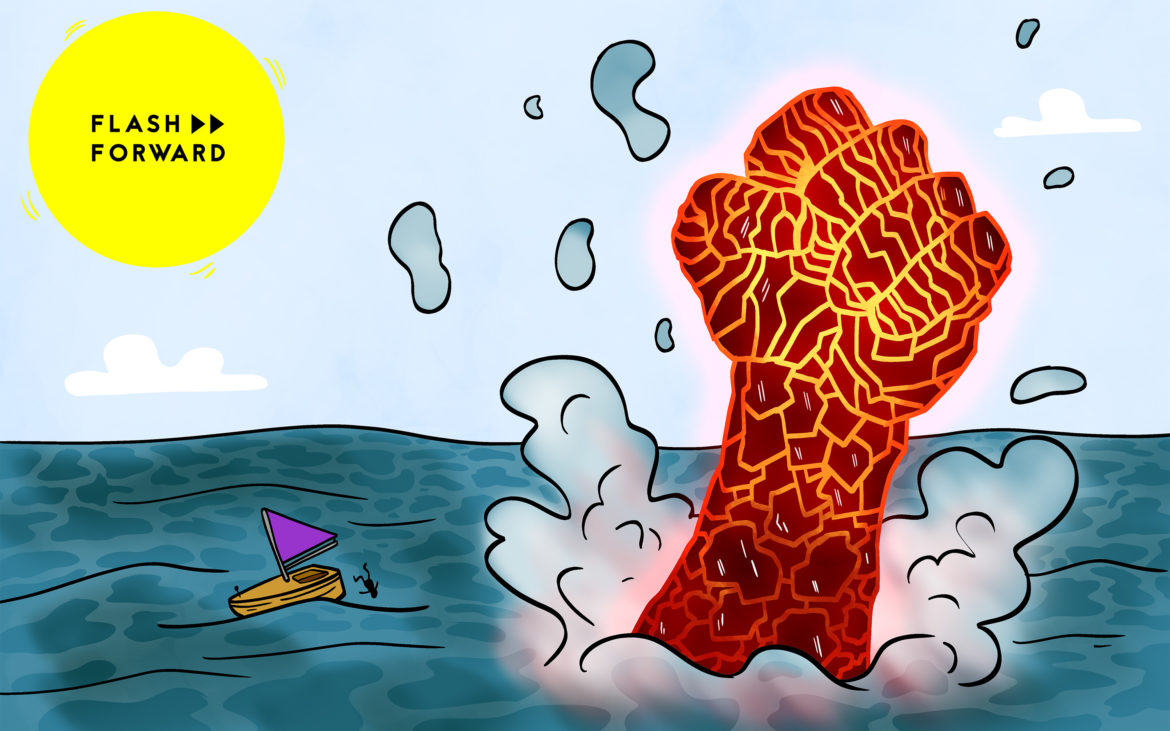
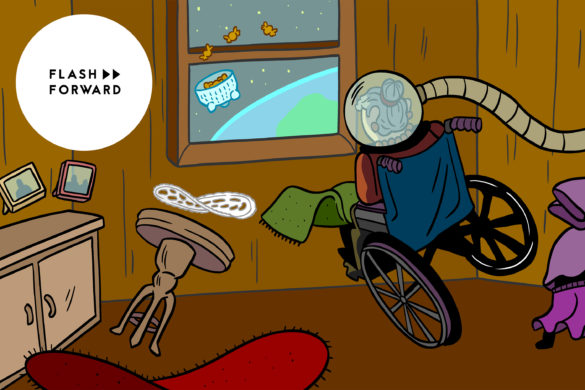
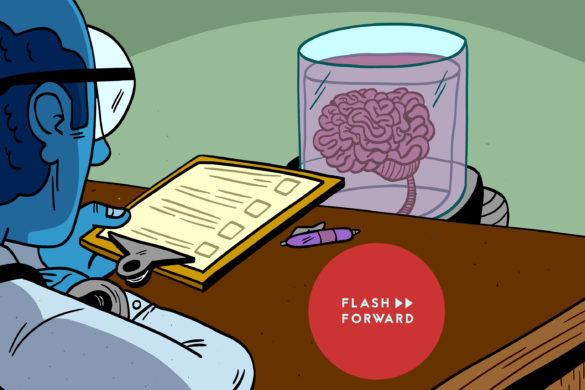
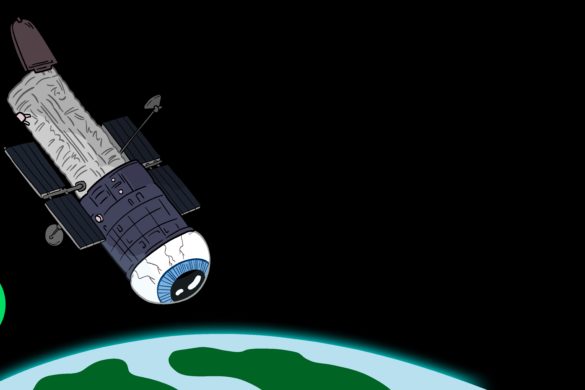
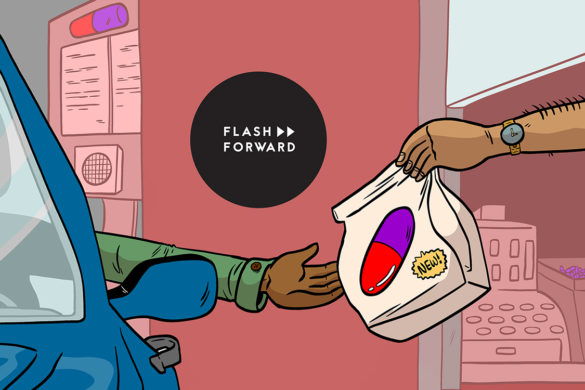
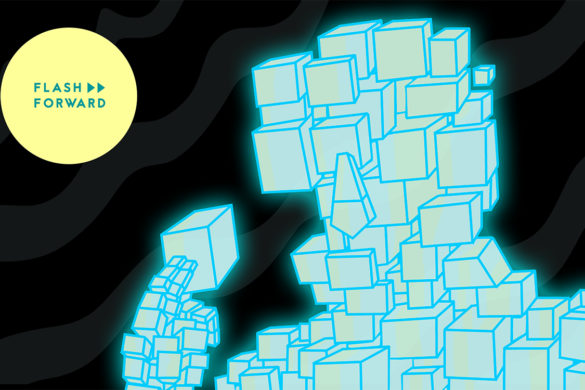
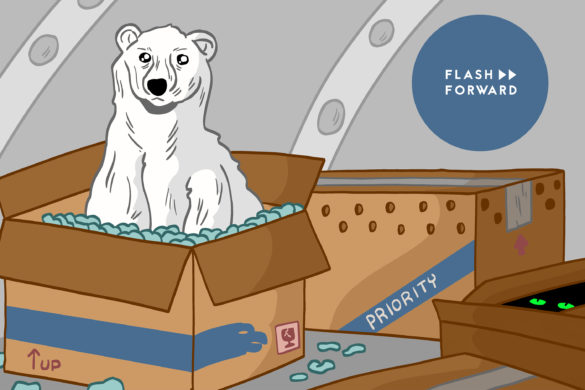
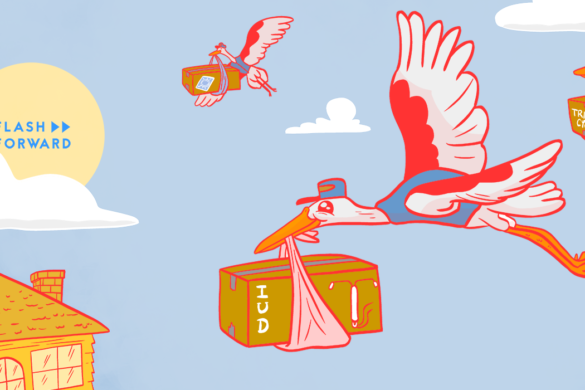
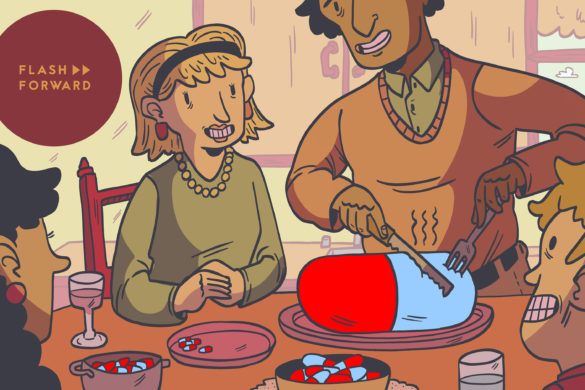
1 comment
[…] 29. Fire from the Deep, April 2018https://www.flashforwardpod.com/2018/04/10/fire-from-the-deep/?fbclid=IwAR14sa1TL-D76h8LLeBK9CXlfmMu… […]